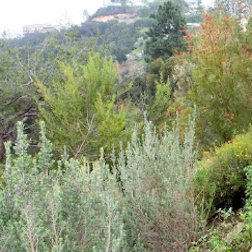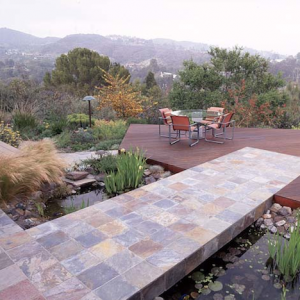Closely mirroring nature produces very clear, meaningful benefits when it comes to landscape design. In the wild, plants tend to locate themselves where they can do the greatest good. As if they have read a little Steven Covey, those that recover well from fire dwell in fire prone locations, while those with the will to retain slopes head for the hills. Left to their own devices, plants will also find their ideal companions.
Nature’s design expertise was on full display during our most recent Hike and Learn for Theodore Payne Foundation. Together, we observed the foliage combinations, spacing and textures that fill us with a sense of beauty. The two FormLA Landscaping gardens featured on the 11th annual Theodore Payne Foundation Garden Tour mimic nature’s savvy tapestry.

The Rosen garden in Brentwood sits along the ridgeline of Mandeville Canyon and the Santa Monica Mountains. This very delicate interface between wild and human spaces presents extraordinary run-off, fire, and erosion related challenges as well as the opportunity for amazing views.
Foliage happy retaining the delicate south-facing slope includes: Artemisia californica (Wormwort), Aster chilensis, and Baccharis ‘Pigeon point’ (Coyote Bush). This combination echoes a coastal scrub community while providing striking silvery fernlike foliage, combined with deep greens and purple flowers.
To com plement a north-facing slope deeply shaded by oak, we mimicked a mixed evergreen and dry riparian plant community. Our plant palate includes a combination of Carpenteria californicas (Bush Anemones), Calycanthus occidentalis (Spice Bush), Artemisia douglasiana (Mugwort), Ribes indecorum (Chapparal Current). This lush combination provides visual interest while protecting the oak canopy from overwatering.
plement a north-facing slope deeply shaded by oak, we mimicked a mixed evergreen and dry riparian plant community. Our plant palate includes a combination of Carpenteria californicas (Bush Anemones), Calycanthus occidentalis (Spice Bush), Artemisia douglasiana (Mugwort), Ribes indecorum (Chapparal Current). This lush combination provides visual interest while protecting the oak canopy from overwatering.
Next month, we’ll look at the natural combinations used in Weiss garden to create retreat within mid-town Santa Monica’s much more urban space.